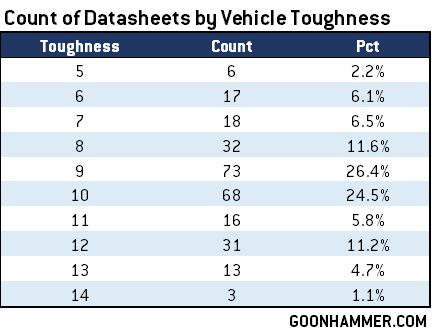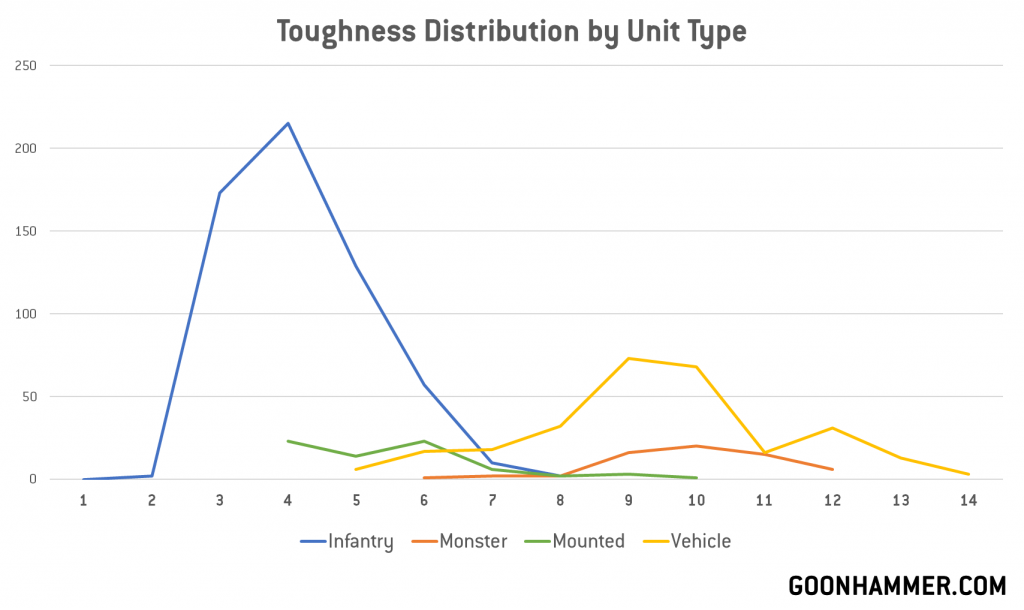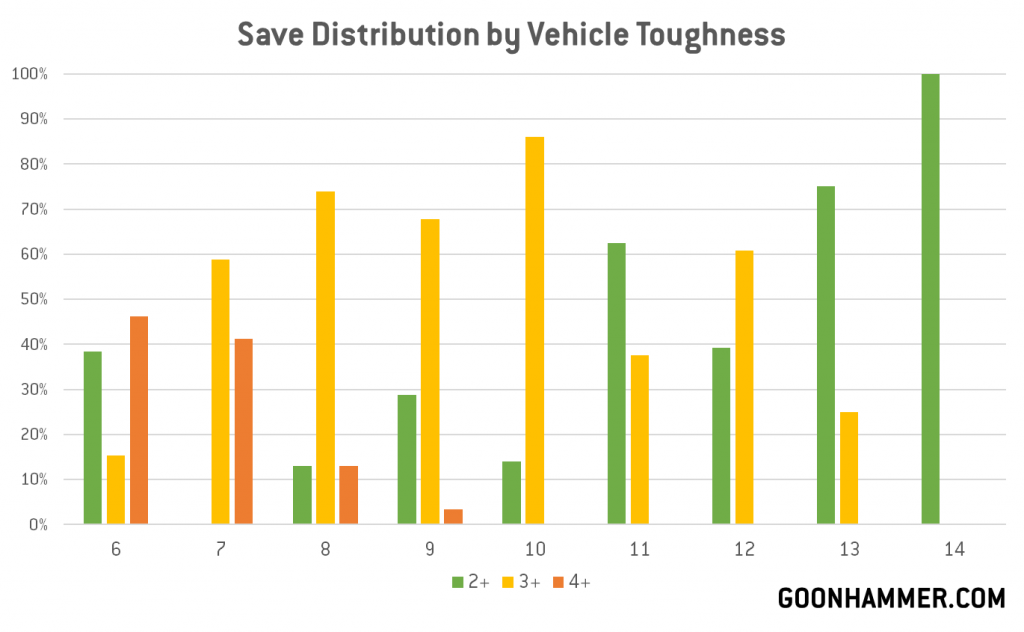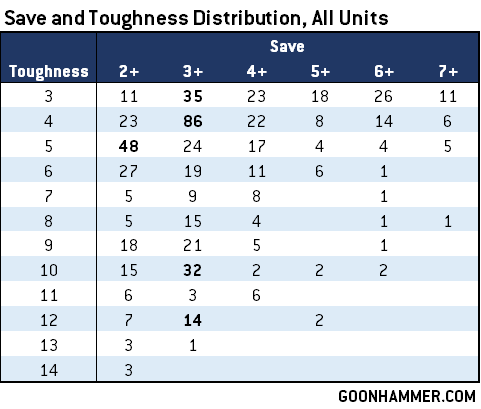Hello, Dear Reader and welcome back to Robert “TheChirurgeon” Jones subbing in for another Hammer of Math. This week we’re taking a look at the juicy data in all of those free datasheets Games Workshop released over the past month for 10th edition and seeing what we can learn from just the raw data available to us for the 1,100 or so datasheets that have been released.
With any project like this, the challenge is as much about figuring out which questions to ask as it is the answers. In looking for a good starting point, I thought it might be prudent to start with the datasheets, and look at how common different statlines and values are.
Note before we dive into this that I’m only looking at data for the game’s standard datasheets, and not currently including Forge World/Imperial Armour Index units. We may add those in and redo the analysis at a future date.
Unit Toughness
Let’s start with unit Toughness. One of the biggest changes of 10th edition was changing the Toughness scale for vehicle and monster units, reducing the soft cap of 8/9 and allowing those units to have up to 14 Toughness. However the flip side is that most weapon strengths stayed in the same range, meaning vehicles generally got tougher to wound. We can take a look at this by looking at vehicle Toughness values:
Whereas in 9th edition the vast majority of vehicles had Toughness 7, with a smattering of T6 and T8 for lighter and heavier vehicles, respectively, we now see that more than two thirds of the game’s vehicles are T9+, with more than half falling in the T9-10 range. This is also true for monsters, where most datasheets have T9-11, depending on the size. We can get a good idea of how toughness values fall out for each major unit type by plotting these:
Of course, toughness values are only half (or one-third, really) of the equation when we’re talking about how durable a unit is, so let’s next turn to saves.
Save Values
Generally speaking, that high Toughness on Vehicles and Monsters also tends to come with good saves. Nearly two thirds of vehicles have a 3+ save (65%) regardless of Toughness, and another 25% come with a 2+ save. There are a few – notably lighter vehicles with lower toughness – on the 4+ end, but no Vehicle in our dataset had worse than a 4+ save. And for the most part, 2+ saves tended to be distributed to higher-toughness vehicles, though Broadsides and some other options notably skew this a bit to create a category of T6 2+ save vehicles.
For Monsters the distribution is a bit different: Nearly half of the game’s monsters have a 2+ save (48%), with another 25% having a 3+. Though unlike vehicles, monsters are much more likely to have worse saves, with 11% of them having a 5+ or worse.
Of course, we also have to talk about Invulnerable Saves. Just under half of 10th edition vehicles (47%) have an Invulnerable save of some kind, though these are not as necessarily distributed how you might think. Vehicles are more likely to have an invulnerable save if they have T6, 7, or 8. 5+ Invulnerable saves are the most common here, making up 53% of the invulnerable saves you find on vehicles. 6+ saves are about as common as 4+ saves. Note that this does not include vehicles which can gain an invulnerable save, like the Wraithknight, though at the time of this writing no one takes the shield on the Wraithknight anyways.
There are a couple of clear jumps here we can talk about – going from T7 to T8 is a pretty big jump, resulting in 2.5 additional wounds on average. Most T8/9 vehicles have 10 wounds, though there are a fair number of T9 vehicles with 8W and 13W – T9 is a bit of an outlier here. There’s another 2-wound jump at T10, where the vast majority of vehicles have 11-13 wounds, and then at T12 we hit our Titanic bump, and we start to see a large number of vehicles with 16 and 22 wounds. At T13+ the average is pretty consistently 24 wounds.
Again, this is different for Monsters, where Toughness values top out at 12. Monsters tend to average 8-10 wounds until you hit T10, at which point they jump up to 13, and at T12 the average monster has 18 Wounds.
The Marine Equivalent and Other Common Profiles
Let’s end this by talking about common profiles. one staple of older analyses was to look at “MEQ” statlines when determining the effectiveness of a weapon. If you haven’t heard the term, “MEQ” in this case stands for “Marine EQuivalent” as a statline, and traditionally referred to a T4, 3+ save, 1-wound statline (though later this changed to be 2W). It’s still a helpful barometer for determining killiness, but given the changes to datasheets in 10th edition and our ability to mine them, it’s worth asking if there are other more important statlines to look at when evaluating weapons.
Our first pass shows a few different points of interest, which I’ve highlighted in bold above. T4 3+ is obviously our marines number, though it may be worth investigating the T4 2+ and 4+ buckets. T3 3+ is another solid one, and that’s where Sisters of Battle live. T5 2+ is another big one, the Terminator statline. And at higher toughness values we should look at T10 3+ and T12 3+ as potential buckets to consider for heavier vehicles.
If we further break this down we can see that the T4 3+ bucket has a large number of 2- and 4-wound entries, with the latter being mostly characters who attach to units. We can (and should) continue to use the T4 3+ 2W bucket for our analyses here, though it may occasionally be worth mentioning the 3W and 4W buckets.
When it comes to our 2+ save profiles, Terminators dominate here – the 3-wound T5 2+ save profile is the most common. Again there are a large number of 5- and 6- wound options, but as with before these represent Terminator characters for the most part. These also all have a 4+ save, so we’ll take that into consideration as well.
As for our T3, 3+ save group, well they mostly have 1 wound. These also tend to have an invulnerable save so we’ll keep that one in mind. There’s also the T3 5+ zone where guardsmen and genestealer cultists tend to live, and that’s worth some consideration as well.
For our T10 Bucket we’ll want to consider targets with 12 wounds, which make up the majority of targets here – so T10, 3+ save, 12W and we’ll include a 5+ invulnerable save for the group given it’s pretty common. And for our T12 bucket we’ll be looking at 22W as the target. We’ll also factor in a 5+ invulnerable save for our T12 bucket.
So when evaluating weapons we typically want to consider how they’ll do against the following profiles:
Infantry
- Marine Equivalent – T4, 3+ save, 2W
- Sister Equivalent – T3, 3+ save, 6+ invuln, 1W
- Guard Equivalent – T3, 5+ save, 1W
- Terminator Equivalent – T5, 2+ save, 4+ invuln, 3W
Characters
- Power Armor – T4, 3+ save, 4W, 4+ invuln
- Terminator Armor – T5, 2+ save, 6W, 4+ invuln
Vehicles & Monsters
- War Dog Equivalent – T10, 3+ save, 12W, 5+ invuln
- Knight Equivalent – T12, 3+ save, 22W, 5+ invuln
- Monster Equivalent – T9, 2+ save, 10W, 4+ invuln
There are a few extra points we could look at, but it’s noteworthy that anything which shreds a War Dog will also make quick work of a Rhino and likewise for anti-marine shooting against guard and weaker targets (the 2W distinction is mostly helpful for understanding damage spillover and soaking attacks).
Next Time: Weapons, Probably
That does it for today’s update. I may or may not be back next week but the next time I do come back, I’ll cover weapon stats, most likely. Until then, if you have any questions or feedback, drop us a note in the comments below or email us at contact@goonhammer.com.







